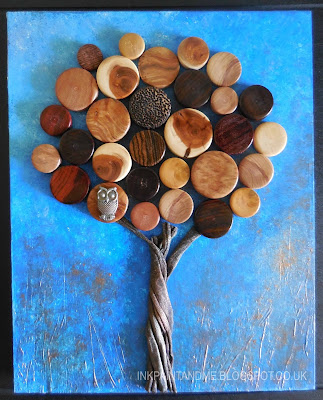Anyway, at the end of each session on her trusty lathe, there is this small disc of wood, which she polishes and puts into a little box.
Well - I couldn't pass up the challenge of doing something with them!
I've used a wooden box frame, with acrylic paint for the background, a bit of texture created with the gesso layer, and copper gilding wax. The tree truck is made from fabric dunked in fabric hardener (Powertex). I've also added a little airdry clay owl. We called this creation Watcher in the Wood ...
Since Laura has been wood turning, I've learned so much about wood, and the amazing array of colours you find beneath the bark.
Sticking with a tree theme, this from Emily Dickinson makes me smile -
Not at Home to Callers
Says the Naked Tree -
Bonnet due in April -
Wishing you Good Day -





